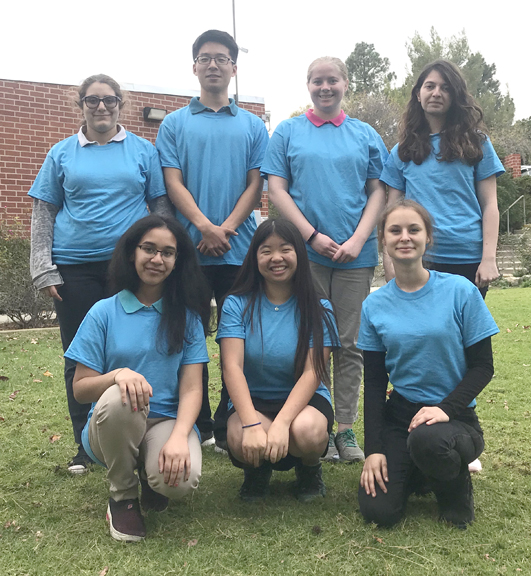
The winning Clark Magnet High School team, the Air Allies, from left, Shreeja Guntireddy, Shaye Holladay McCarthy, Anna Feddersen, Shelia Mgrtichian, Paul Kim, Emily Woods and Serli Khanbabaei.
By Charly SHELTON
Clark Magnet High has done it again.
The Lexus Eco Challenge offers high school students a chance to get environmentally involved and find practical ways of researching and improving the environment to make a better tomorrow. And, once again, the environmental geographic information system class at Clark Magnet High School entered and won one of the challenges.
“This year the students formed a team called the Air Allies. They wanted to study the problem of air pollution, to see how much air pollution there was in our area,” said Dominique Evans-Bye, EGIS class teacher at Clark. “So I got them personal air quality monitors called Atmotubes. They sell them online and [the students] researched and said that’s what they needed for their project this year. So I got eight of them for the team and they created a map in ArcGIS online.”
The map was used to assign areas of the Crescenta Valley and Glendale to different classmates who were given tubes to collect samples of the air quality in their area. Then all the data was brought back in to compile into a type of interactive map called a Geographic Information System (GIS). In the same way Yelp or Google Maps has little buttons on the map for businesses located at their address, with pop-ups containing information about the hours and menu, so too does the GIS map have data programmed into these points on a map. But instead of ratings for the best breakfast burrito, for example, the class map had info about how many parts in the air per million were CFCs (chlorofluorocarbons) and carbon monoxide. This data plotted on a map enabled the class to see overall trends across vast swaths of land.
“They told a story about air pollution – how it formed and why it’s damaging, what it can do to you and what our air quality is like,” Evans-Bye said. “The [surveyed areas’] air quality is pretty good but an area of concern they found was the potential re-opening the Grayson Power Plant [in Southwest Glendale near the 5 and 134 interchange] as a gas-fired power plant and how that would affect our air quality. They identified that might be an area in the future where we go from ‘fair to good air quality’ to ‘not so good air quality.’”
Beyond the immediate importance of the project, winning the Air Climate Challenge portion of the overall program has given the students a major achievement to be proud of. And also the prize money, with some being put away for funding future class projects, some given to the school and teachers who put in supplemental work and the rest divided among the students for scholarship money.
“Most of that money goes directly to the students. I just love giving them the opportunity to enter a competition and to get that award on the resume so, when they apply to colleges or a job later on, it becomes something that sets them apart,” Evans-Bye said. “Along with having a little bit of scholarship money they can use for college.”
And now that the challenge is won, with the fresh influx of funds it’s time to expand their project to go international. Working with staff across the Glendale Unified School District and with staff at Glendale City College, the students have plans to send their Atmotubes around the world to collect data.
“They reached out to families and friends, professors, anyone traveling abroad out of the country, to please take one of our little Atmotubes with you and collect data for us. So far they’ve got data from Mexico, from Peru, [and] one of the students took it to Alaska,” Evans-Bye said. “Spring break is going to be a big data collection time for us because GCC is out [for the break] and the school districts are out [at the same time] so we’ve got people that are going all throughout Europe, the Middle East, Bali. And they’re starting out this time to kind of put a human face to it. They’re asking the volunteers who are doing it if they would take a selfie of themselves using the Atmotube. They created a little survey for them to answer about how the experience went for them and to give a statement about the project and what they found. The teacher who went to Mexico actually got an alert on her phone that told her to evacuate the area; the air quality [was] so bad right there [she was] in danger and [she] had to leave. That was eye-opening because it didn’t smell any different to her; it must’ve been carbon monoxide or something.”
Evans-Bye wants to express her thanks to Lexus for this program and all they do for the community. Over the past 12 years of the Eco Challenge, she said, Lexus has given out over $5 million in awards and about $400,000 of that has gone to Clark Magnet High through winning Eco Challenges.
For more information on the Lexus Eco Challenge, visit Scholastic.com/Lexus.
